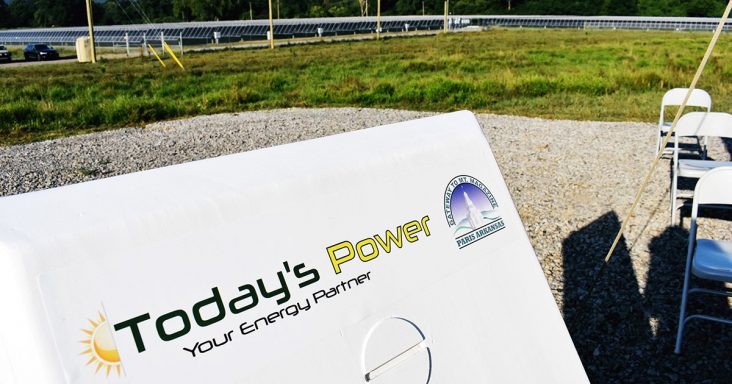Today’s Power completes multiple solar arrays; renewables growth expected to continue
by July 20, 2021 2:31 pm 485 views

North Little Rock-based renewable energy company Today’s Power Inc. (TPI) recently completed solar arrays for two school districts and a water association in south Arkansas as electricity sales and generation from renewables are expected to increase through 2022.
Star City School District and Yorktown Water Association recently celebrated the completion of two solar projects comprising 1.5 megawatts on 12 acres in Star City, the county seat of Lincoln County. TPI owns the arrays and has a 20-year agreement to sell the electricity they generate to the school district and water association. Construction of the solar project started in late 2020 and was completed in June.
“Through technology and collaboration, this project exemplifies a forward-thinking approach to meeting the future needs of both the school district and Yorktown Water,” said TPI President Michael Henderson. “This project demonstrates that working together to co-locate their individual projects at one location saves on site development, construction efficiencies and grid interconnection costs, resulting in overall savings for SCSD and YWA.”
The 1-megawatt single-axis tracking array for the school district will generate about 1.97 million kilowatt-hours annually and meet about 75% of the school district’s electricity needs. C&L Electric Cooperative will provide the remaining electricity demand.
The 500-kilowatt array for the water association will provide 64% of its electricity needs, producing 1.01 million kilowatt-hours annually.
TPI also recently completed a 720-kilowatt array for Hampton School District in Calhoun County. The array is expected to provide more than 90% of the campus’ energy consumption and produce more than 1.24 million kilowatt-hours annually. Ouachita Electric Cooperative will provide the remaining electricity demand. The array comprises more than 2,000 panels.
“We are excited to partner with Hampton Schools as they fulfill their mission,” Henderson said. “Embracing leading-edge technology so all of their students receive benefits of lower cost and contributing to a cleaner environment is sending the right message to the over 600 students they represent.”
U.S. retail sales of electricity are expected to increase by 2.8% in 2021, and renewable energy is projected to contribute a greater share of U.S. electricity generation through 2022, according to the U.S. Energy Information Administration (EIA). Renewables are projected to generate 23% of U.S. electricity by 2022, up from 20% in 2020. About 50 gigawatts of solar and wind capacity is set to start operating in the United States over the next 18 months, and 2022 will be the first year that growth in utility solar capacity will exceed wind capacity growth.
According to recent EIA data, the average construction costs for solar photovoltaic systems in the United States continued to decline in 2019, falling by nearly 3% from 2018. The average costs for wind turbines rose less than 1%, or by $9 per kilowatt. Costs for natural gas-fired generators rose almost 29%, or by $241 per kilowatt.
Solar construction costs were $1,796 per kilowatt in 2019. The decline could be attributed to falling costs for crystalline silicon axis-based tracking panels, which decreased to $1,497 per kilowatt in 2019. Crystalline silicon axis-based tracking panels comprise nearly half of the solar capacity added in the United States in 2019, at 2.5 gigawatts. Among solar technologies, crystalline silicon fixed-tilt panels had the highest average cost in 2019 at $2,242 per kilowatt.
